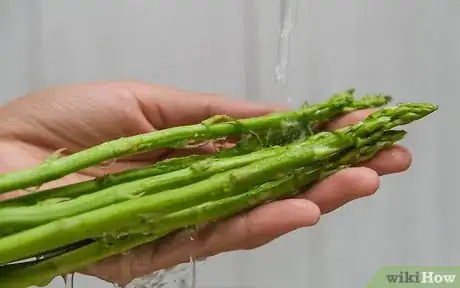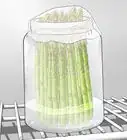This article was co-authored by JoAnna Minneci. JoAnna Minneci is a Professional Chef based in the Nashville, Tennessee area. With more than 18 years of experience, Chef JoAnna specializes in teaching others how to cook through private cooking lessons, team-building events, and wellness and nutrition classes. She has also appeared in numerous television shows on networks such as Bravo and Food Network. Chef JoAnna received Culinary Arts training from the Art Institute of California at Los Angeles. She is also certified in sanitation, nutrition, kitchen management, and cost control.
There are 13 references cited in this article, which can be found at the bottom of the page.
wikiHow marks an article as reader-approved once it receives enough positive feedback. In this case, several readers have written to tell us that this article was helpful to them, earning it our reader-approved status.
This article has been viewed 421,172 times.
Blanching is a cooking technique where the food is cooked in boiling water and immediately chilled in a bath of ice water. Blanching is great for asparagus since it helps preserve the flavor, texture, and color. After you blanch your asparagus, you can either serve it right away, refrigerate it for 3-5 days, or freeze it for up to 1 year. With a bit of preparation, you can enjoy fresh, nutritious asparagus.
Steps
Cooking the Asparagus
-
1Wash your asparagus in cool water to remove superficial dirt. Before you blanch your asparagus, make sure it is clean. Hold the stalks underneath cool water from your sink for 10-30 seconds.
-
2Trim the ends off of your asparagus. To easily chop off the ends, place the asparagus on a cutting board so all of their ends are aligned. Then, use a large, sharp knife to slice off the bottom fourth of the asparagus stems. Remove the white, thick end from the green, slim stalk. Make 1 chop across all of your ends to easily remove it.[1]
- The ends are less flavorful and chewier, making them undesirable to eat.
Advertisement -
3Bring a large pot of water to a boil using a high heat setting. To blanch your asparagus, fill a large pot about halfway full with water from your sink. Then, place the pot on your stovetop and select a high heat setting.[2]
- Your water should come to a boil in about 5 minutes.
-
4Add salt to your water if you want to enhance the flavor. Sprinkle your salt into the water as soon as you turn on the heat. Use about 2 tablespoons (29.6 grams) per 6 cups (1,400 millilitres) of water.[3]
- While adding salt is optional, it helps season the asparagus and help it retain nutrients.
-
5Put your asparagus in the water once it starts to boil. After you see bubbles brewing from your pot, place your clean, trimmed asparagus into the water using your hands. Then, use a slotted spoon or pair of tongs to submerge the asparagus completely in the water.[4]
- As you do this, be careful not to burn yourself on the hot pot or from the steam.
-
6Let the asparagus cook for 2-4 minutes. Your asparagus will be fully cooked in roughly 3 minutes. As they cook, keep an eye on the color of the asparagus.[5]
- Your asparagus is ready when the stalks are bright green.
Submerging the Asparagus in Ice Water
-
1Prepare an ice bath as the asparagus is cooking. After you place the asparagus in boiling water, grab a large bowl and fill it with ice. Then, cover the ice in cold water from your sink. Place the bowl next to the stovetop so you can easily transfer the asparagus.[6]
-
2Transfer the asparagus to an ice bath immediately after it cooks. After about 3 minutes or so, grab your tongs and pinch your asparagus with them. Ensure the asparagus is a bright green color before you take it out of the boiling water. As soon as you lift the asparagus out of the water, drop it into your bowl of ice water. Soak the asparagus for about 1-3 minutes until it is cooled down completely.[7]
- If you overcook your asparagus, it will get soggy and turn a shade of dark green.
- The cold water stops the cooking process and softens your asparagus.
-
3Set the asparagus on a clean towel after about 3 minutes. After the asparagus cools down, remove it from the ice water and place it on a clean kitchen towel or paper towel. Pat the stalks dry to remove the excess water.[8]
Serving and Storing the Asparagus
-
1Eat your blanched asparagus plain if you want a healthy snack or side. After your asparagus is dry, you can simply grab a fork and dig in! Sprinkle a little salt and pepper on top if you’d like some extra flavor.[9]
- For example, you can serve your plain asparagus with a veggie tray for a yummy appetizer. Add fresh carrots, celery, broccoli, and cauliflower for a full spread. Don’t forget the veggie dip!
-
2Chop up your asparagus if you want to put it in a salad. Take your sharp knife, and chop your asparagus into bite-sized pieces. Then, toss the bits with chopped romaine and/or spinach. Add toppings like dried cranberries and goat cheese for a yummy, healthy dish.[10]
- You can add asparagus to any salad you’d like!
-
3Cover your asparagus with balsamic vinegar if you want a tasty sauce. To do this, place your asparagus on a serving platter or onto individual serving plates. Whisk up 3 tablespoons (44.4 millilitres) of balsamic vinegar, 2 tablespoons (29.6 grams) minced of red onion, 2 tablespoons (29.6 millilitres) of olive oil, 1 clove of minced garlic, and a sprinkling of black pepper. Then, pour the mixture over top of your asparagus.[11]
- This makes a delicious side dish or appetizer.
- This mixture is great for 4 servings of asparagus.
- To serve your asparagus warm, throw the mixture into a medium-sized skillet and heat it up for 2-3 minutes.
-
4Serve the asparagus with olive oil and Parmesan for a yummy topping. Put your asparagus into a bowl, and mix in 2 tablespoons (29.6 millilitres) of olive oil, 2 tablespoons (29.6 grams) of grated Parmesan cheese, and 1 teaspoon (4.9 grams) of lemon zest. Sprinkle in salt and pepper to taste, if you’d like. Mix the ingredients all together thoroughly, then serve it in a platter or individual plates.[12]
- If you’d like to serve your asparagus warm, you can skip the ice bath and mix the ingredients while the asparagus is still hot.
-
5Refrigerate your blanched asparagus for up to 3-5 days. For best results, refrigerate your asparagus within 2 hours of blanching it. Wrap the asparagus securely in plastic wrap, and place it in an airtight container, such as Tupperware. Secure the lid, and place the container inside your fridge.[13]
- Eat or freeze your asparagus within about 3 days.
-
6Freeze your asparagus if you want to store it long-term. Line your baking tray with parchment paper, and spread the asparagus stalks across the tray. Place the tray in your freezer for 1-3 hours until the asparagus is completely frozen. Then, take the tray out of the freezer. Pack the freezer bag full of your frozen asparagus. Then, squeeze out as much air as you can. Place the bag in your freezer, and store your asparagus for 8-12 months.[14]
- When you line the tray, leave a bit of room in between the stalks.
- Alternatively, place your frozen asparagus in a freezer-safe container, like a Tupperware bin.
- You can use a marker to label the bag or container with the date you froze it, if you’d like.
- To cook with frozen asparagus, remove the stalks as needed.
Community Q&A
-
QuestionDo I have to blanch them?
 KateKatey GirlCommunity AnswerIf you're going to freeze the asparagus, most people prefer to blanch it first. I put them in a Ziploc bag and freeze without blanching.
KateKatey GirlCommunity AnswerIf you're going to freeze the asparagus, most people prefer to blanch it first. I put them in a Ziploc bag and freeze without blanching. -
QuestionWhat does it mean to blanch asparagus?
 Drew Hawkins1Community AnswerBlanching is a specific cooking technique where the food is cooked in boiling water for a brief period of time and then immediately chilled in a bath of ice water. Blanching is great for a couple of different purposes. You can blanch asparagus before you can or pickle it. You can also blanch it before you freeze it to help it last longer. The most common reason to blanch asparagus is to cook it so it's tender but still has a nice crunchy texture. It also helps the vegetable keep its vibrant green color, rather than the dull complexion that can sometimes happen when you boil asparagus. Blanching is also super easy to do, making it an easy way to prepare asparagus.
Drew Hawkins1Community AnswerBlanching is a specific cooking technique where the food is cooked in boiling water for a brief period of time and then immediately chilled in a bath of ice water. Blanching is great for a couple of different purposes. You can blanch asparagus before you can or pickle it. You can also blanch it before you freeze it to help it last longer. The most common reason to blanch asparagus is to cook it so it's tender but still has a nice crunchy texture. It also helps the vegetable keep its vibrant green color, rather than the dull complexion that can sometimes happen when you boil asparagus. Blanching is also super easy to do, making it an easy way to prepare asparagus. -
QuestionHow long do you blanch asparagus for freezing?
 Drew Hawkins1Community AnswerProperly blanching your asparagus can help it last longer and keep its bright green color when you store it in the freezer. Start by trimming the ends off, which are less flavorful and chewier. Bring a large pot of water to a rolling boil and add about 2 tablespoons (29.6 grams) per 6 cups (1,400 millilitres) of water. Add your asparagus into the boiling water and let it cook for about 3 minutes, until the stalks are bright green. Then, transfer them immediately into an ice bath. Let them soak for about 2-3 minutes so they cool down fully. You can then put them in plastic freezer bags. Squeeze out all the air and seal them shut tightly before you stick them in the freezer. You can keep them there for 8-12 months.
Drew Hawkins1Community AnswerProperly blanching your asparagus can help it last longer and keep its bright green color when you store it in the freezer. Start by trimming the ends off, which are less flavorful and chewier. Bring a large pot of water to a rolling boil and add about 2 tablespoons (29.6 grams) per 6 cups (1,400 millilitres) of water. Add your asparagus into the boiling water and let it cook for about 3 minutes, until the stalks are bright green. Then, transfer them immediately into an ice bath. Let them soak for about 2-3 minutes so they cool down fully. You can then put them in plastic freezer bags. Squeeze out all the air and seal them shut tightly before you stick them in the freezer. You can keep them there for 8-12 months.
Things You’ll Need
- Asparagus
- Knife
- Pot
- Water
- Bowl
- Ice
- Salt (optional)
- Tongs
- Freezer bag or airtight container (optional)
References
- ↑ https://www.thekitchn.com/how-to-blanch-asparagus-cooking-lessons-from-the-kitchn-187729
- ↑ https://youtu.be/G3RTj25gl0s?t=54s
- ↑ https://www.thekitchn.com/how-to-blanch-asparagus-cooking-lessons-from-the-kitchn-187729
- ↑ https://youtu.be/G3RTj25gl0s?t=56s
- ↑ https://youtu.be/G3RTj25gl0s?t=1m9s
- ↑ https://youtu.be/G3RTj25gl0s?t=1m20s
- ↑ https://youtu.be/G3RTj25gl0s?t=1m40s
- ↑ https://youtu.be/G3RTj25gl0s?t=2m16s
- ↑ https://youtu.be/G3RTj25gl0s?t=2m20s
About This Article
Blanching helps bring out the color and flavor of vegetables while preserving their texture and nutrients. To blanch asparagus, start by rinsing the asparagus under cool, running water. Trim off the bottom ¼ of the stems, then set the asparagus aside and bring a pot of water to a boil over high heat. If you want to enhance the flavor of the asparagus a little, add 2 tablespoons (30 g) of salt per 6 cups (1.4 L) of water. Once the water reaches a boil, put the asparagus in the pot and push it down with tongs or a spoon so it’s completely submerged. Let the asparagus cook for about 3 minutes or until the stalks turn bright green. Use tongs to move the asparagus into a bath of ice and cold water, which will stop them from cooking any further. Let the asparagus sit in the ice bath for 1-3 minutes, then transfer it to a clean kitchen towel or paper towel. Serve the asparagus right away or freeze it for later use. For more tips, including how to serve your blanched asparagus, or store it if you don't immediately want to eat it, read on!






















































